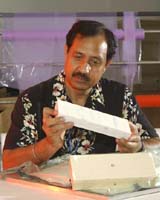Last fall, the Sun was busy. It wasn't just bringing us light and warmth -- it was busy exploding. One of the most violent periods of solar activity in 60 years posed no danger to us, but triggered magnetic storms in Earth's atmosphere.
If your cell phone didn't work or your favorite radio station was off the air, you may have experienced some of the effects of the storm. Satellites and people in space took precautions to limit their exposure to increased radiation levels resulting from the storm. The two-man crew of the International Space Station crew spent brief periods in the area of the Station with maximum radiation shielding.
But how will NASA ensure the safety of future space crews, those likely to travel in space for longer periods as they explore other planets or work on orbiting facilities? These crews will be exposed not only to solar particles but also to the high-energy, highly charged particles that make up the ever-present galactic cosmic rays that permeate the deep space environment.
To build a better shield, you need one that absorbs or at least fragments more of the radiation -- keeping some of it from ever reaching space faring crews and rendering it less harmful so as to reduce their radiation exposure to acceptable levels. To build better shields, you need new materials and a better understanding of the physics of the particle interactions with different materials. The search for these materials is underway by the Radiation Shielding Program -- part of a strategy of the NASA Office of Biological and Physical Research to limit space crews' radiation exposure.
"To solve this complex radiation challenge, we have assembled a team of experts from multiple private, public and educational institutions," said Ed Semmes, who manages the Radiation Shielding Program at NASA's Marshall Space Flight Center in Huntsville, Ala. "Our team includes engineers, materials scientists and physicists from the Marshall Center and from Langley Research Center in Hampton, Va."
The team is examining new shielding materials that not only block and/or fragment more radiation than aluminum -- the material currently used to build most spacecraft structures -- but also are lighter than aluminum. Spacecraft designers have to be able to shape shielding materials to make various parts of the spacecraft. The material must protect the crew from radiation, and it must also deflect dangerous micrometeoroids. The shielding must be durable and long lasting -- able to stand up to the harsh space environment.
Polyethylene is a good shielding material because it has high hydrogen content, and hydrogen atoms are good at absorbing and dispersing radiation. In fact, researchers have been studying the use of polyethylene as a shielding material for some time. One of several novel material developments that the team is testing is reinforced polyethylene. Raj Kaul, a scientist in the Marshall Center's Engineering Directorate, previously has worked with this material on protective armor for helicopters.
"Since it is a ballistic shield, it also deflects micrometeorites," Kaul says. "Since it's a fabric, it can be draped around molds and shaped into specific spacecraft components."
Kaul makes bricks of the material by cutting the fabric and layering 200 to 300 pieces in a brick-shaped mold in his laboratory at the Marshall center. He then uses a vacuum pump to remove air and prevent bubbles in the material, which would reduce its strength. The material is "cooked" in a special oven called an autoclave, which heats the material slowly to 200 degrees Fahrenheit while putting it under pressure of 100 pounds per square inch using nitrogen gas. The combination of heat and pressure causes the chemical reaction that bonds the layers together to form a brick weighing about half as much as a similar piece of aluminum.
"Fiber is the secret of the material's strength, " explains Kaul. "Bulk materials usually are not as strong because they are more likely to have defects. A spider's web is strong because it is made of individual fibers."
But building a better shield is only half the answer to the problem. If too much shielding material is used, the spacecraft becomes way too heavy to get off the ground. So NASA is also working on medical countermeasures that limit the effects of radiation on space crews.
The Space Radiation Health Project at NASA's Johnson Space Center in Houston involves scientists nationwide at universities and medical centers. They are investigating how space radiation damages cells and tissues such as the eyes, brain and internal organs. This information can be used to develop effective medical treatments that limit damage done by radiation exposure.

